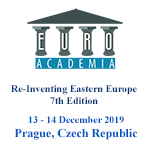Euroacademia Conferences
 Europe Inside-Out: Europe and Europeanness Exposed to Plural Observers (9th Edition) April 24 - 25, 2020
Europe Inside-Out: Europe and Europeanness Exposed to Plural Observers (9th Edition) April 24 - 25, 2020 Identities and Identifications: Politicized Uses of Collective Identities (9th Edition) June 12 - 13, 2020
Identities and Identifications: Politicized Uses of Collective Identities (9th Edition) June 12 - 13, 2020 8th Forum of Critical Studies: Asking Big Questions Again January 24 - 25, 2020
8th Forum of Critical Studies: Asking Big Questions Again January 24 - 25, 2020 Re-Inventing Eastern Europe (7th Edition) December 13 - 14, 2019
Re-Inventing Eastern Europe (7th Edition) December 13 - 14, 2019 The European Union and the Politicization of Europe (8th Edition) October 25 - 26, 2019
The European Union and the Politicization of Europe (8th Edition) October 25 - 26, 2019 Identities and Identifications: Politicized Uses of Collective Identities (8th Edition) June 28 - 29, 2019
Identities and Identifications: Politicized Uses of Collective Identities (8th Edition) June 28 - 29, 2019 The European Union and the Politicization of Europe (7th Edition) January 25 - 26, 2019
The European Union and the Politicization of Europe (7th Edition) January 25 - 26, 2019 7th Forum of Critical Studies: Asking Big Questions Again November 23 - 24, 2018
7th Forum of Critical Studies: Asking Big Questions Again November 23 - 24, 2018 Europe Inside-Out: Europe and Europeanness Exposed to Plural Observers (8th Edition) September 28 - 30, 2018
Europe Inside-Out: Europe and Europeanness Exposed to Plural Observers (8th Edition) September 28 - 30, 2018 Identities and Identifications: Politicized Uses of Collective Identities (7th Edition) June 14 - 15, 2018
Identities and Identifications: Politicized Uses of Collective Identities (7th Edition) June 14 - 15, 2018
The Conflict of American and Russian Influence on the Territory of the Former Yugoslavia
-
-

-
Presentation speakers
- Andrej Rendic, University in Zadar, Croatia
Abstract:
The territory of former Yugoslavia has historically been marked by a lasting conflict of civilizations and religions, to which nowadays the conflict of geopolitical interests of Russia and the USA, respectively, adds its share. With the fall of communist regimes in the 1990’s and the ensuing dismemberment of former Yugoslavia, new national states came into existence, destabilizing the whole region and ultimately leading into chaos which took the shape of the sanguinary Yugoslav Wars. Among other things, the period of war was distinguished by the relative absence of the influence of global superpowers. Whereas the USA were preoccupied with the Iraq War, Russia was being shaken by internal political turmoil. In 1993, however, the territory returned into the focus of American foreign political ambitions as the USA established itself as the main mediator in the network of external diplomatic efforts to end wars in Croatia and Bosnia and Herzegovina, respectively. Following this, in the late 1990’s, with the help of NATO, the USA continued to fasten their presence and influence in the region, the most important expression of which were its active efforts to bring the Kosovo War to its end. Meanwhile, the other superpower and the USA’s contender for the influence in the region, the then reborn and politically restabilized Russia namely, made its comeback to the geopolitical stage on the territory of former Yugoslavia and began aiming at retaining its political grip on Serbia, Montenegro and, partly, Bosnia and Herzegovina. The USA on their part, strengthened by their recently succeeded mission in Kosovo, continued working on maintaining their position of power through the so-called Euro-Atlantic perspective, that is, through fostering the integration of former Yugoslavian member states into the EU and NATO. The Republics of Croatia and Slovenia eventually became NATO and EU member states. Additionally, even Albania and, prospectively, Macedonia were taken under the wing of NATO. Then, a little more than a decade after, in 2016, the conflict between Russian and American interests in Montenegro began to escalate, culminating in the Russian involvement in the unsuccessful coup d’état in Montenegro following the latter’s entry into NATO in 2017, which ultimately led to definitive distancing of that former Yugoslav state from the Russian sphere of influence. This was undoubtedly the greatest blow to Russia’s political interests on the territory of the former Yugoslavia since the end of the Yugoslav Wars. Conversely, it allowed the USA to achieve their strategical goal and prevent Russia’s encroachment upon the Adriatic Sea and to thus draw all the countries bordering on that sea under the NATO umbrella. This paper analyzes the momentary relationships and potential future developments concerning the American and Russian influence on the territory of former Yugoslavia. With respect to this, it poses several questions. What are the ways in which Russia attempts to keep its influence in the region? Who are the main actors in related struggles for political power? What are the principal instruments by which the USA and Russia, respectively, seek to promote their interests?
-
Related Presentations

Please Close the Gap! New Development Models of CEE Economies?
- Sebastian Kinder
- Jan Peter Kosok

Looking towards East on 16th Century Maps
- Ioana Zamfir













